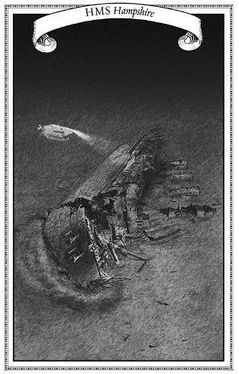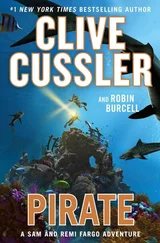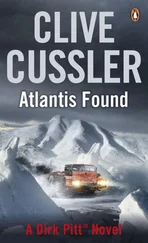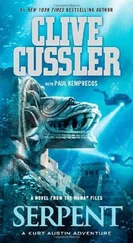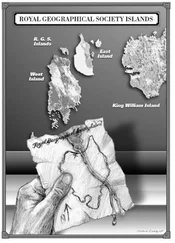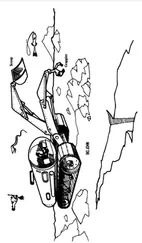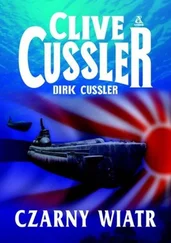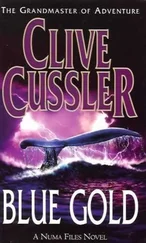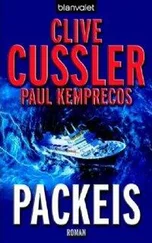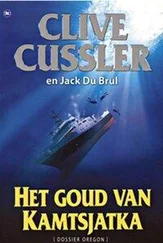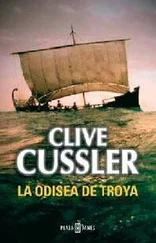Pounding over the waves just over two miles away was a high-performance motor yacht headed directly for the Aegean Explorer . It was Italian built, with wraparound smoked-glass windows and a large open stern deck. A red Turkish flag with white crescent and star flew from a mast, along with a smaller red flag that featured a single gold crescent. Though it was far smaller than a Monte Carlo show yacht, Pitt still could see that it was an expensive luxury boat. The three men watched as the yacht closed to within a half mile before slowing to a halt, where it bobbed on the unsettled waters.
“I wouldn’t be too concerned about your wreck, Rod,” Gunn said. “They don’t exactly look like they’re here to perform excavation work.”
“Probably somebody just nosing about to see what a research ship is doing parked out here,” Pitt said.
“Or perhaps we’re blocking the view of someone’s villa on shore,” Gunn muttered.
Pitt assumed that no one besides Ruppé knew of the location of the wreck site. Perhaps he had already notified the Turkish Ministry of Culture, he considered. But then he remembered that Ruppé’s office had been burglarized and his chart to the site stolen with the artifacts. His concern was diverted when he heard his name shouted from the forward part of the ship. He turned to see Giordino hanging his torso out of a work bay door beneath the bridge.
“Some info from Istanbul just came in for you over the wire,” Giordino shouted.
“Speak of the devil,” Pitt muttered. “Be right there,” he yelled back, then turned to the other two men.
“I bet that is Dr. Ruppé’s analysis of our earlier artifacts from the wreck.”
“I’d like to see his results,” Zeibig said.
The two divers quickly changed clothes, then met up with Pitt and Giordino in the small bay, which housed several computers linked to a satellite communications system. Giordino handed Pitt a multipage printout, then sat down at one of the computers.
“Dr. Ruppé also e-mailed a couple of photographs with the report,” he said, tapping at a keyboard to open an electronic file. A close-up image of a gold coin filled the computer screen.
Pitt quickly scanned the report then passed it to Zeibig.
“Are we still looking at an Ottoman wreck?” Gunn asked.
“Almost certainly,” Pitt replied. “Dr. Ruppé found a representative coin from a mint in Syria that he believes is identical to one of the coins in Al’s lockbox. It dates to around 1570. Unfortunately, Ruppé says he had to base the comparison on memory, since the coins were stolen from his office.”
“I’d have to agree with him,” Giordino said. “It looks like the same coin to me.”
“The mint marks were known to have been used between 1560 and 1580,” Zeibig said, reading from the report.
“So we know the wreck is no older than 1560,” Gunn said. “A shame the whole box of coins was taken, as that might have zeroed things in a bit more.”
“The other dating clue was the ceramic box that held the crown,” Pitt said. “As Loren and I discovered at the Blue Mosque, the particular design indicates the tiles came from the kilns of Iznik.”
Giordino clicked to the next few photographs, which showed a number of known tile samples from Iznik.
“Unfortunately, the ceramic box was also taken from Ruppé’s office, so again we’re working from memory.”
“His report indicates that the tiles incorporate patterns and colors that were popular with Iznik ceramics in the late sixteenth century,” Zeibig noted.
“At least we have some consistency,” Giordino noted.
“I can also attest that from what I saw of the wreck’s framing, it corresponds with known sixteenth-century vessel construction in the Mediterranean,” Zeibig added, looking up from the report.
“That’s three for three,” Gunn said.
“Which brings us to King Al’s crown,” Pitt replied with raised inflection.
Giordino pulled up a new photograph, which showed a detailed image of the gold crown. The seabed encrustations had all been cleaned from it, leaving a sparkling headpiece that looked as if it had just left the goldsmith.
“Thank goodness my baby was kept safe in Dr. Ruppé’s vault,” Giordino said.
“Dr. Ruppé calls this one of the most significant finds in Turkish waters, as well as one of the most mysterious,” Pitt said. “Despite considerable research, he was unable to utilize the crown’s shape and size as a clue in identifying its provenance. However, after a thorough cleaning, he clarified the faint engraving on the inside of the band.”
Giordino brought up an enlarged photo of the crown while Zeibig thumbed to the description in the report.
“The engraving is in Latin,” Zeibig reported with a quizzical look. “Ruppé translated the inscription as follows: ‘To Artrius, in gratitude for capturing the relic pirates. — Constantine.’”
“Ruppé found records of a Roman Senator named Artrius. It so happens that he lived during the rule of Constantine,” Pitt said.
“Constantine the Great?” Gunn blurted. “The Roman Emperor? Why, he lived a thousand years earlier.”
The room fell silent as everyone stared at the photographic image. Nobody had expected such a disconnect with the shipwreck’s other artifacts, particularly by something as remarkable as the gold crown. And yet there was no clue as to why it was aboard. Pitt inched away from the monitor and stood up, finally breaking the silence.
“I hate to say it,” he said with a grin, “but I guess this means that King Al has been transferred to the Roman Legion.”
Broome Park was a characteristic old english manor. Purchased by Kitchener in 1911, it featured a towering Jacobean-style brick house built during the rule of Charles I, surrounded by 476 acres of lush, parklike grounds. During his short occupancy, Kitchener labored extensively to upgrade the estate’s gardens, while commissioning an elaborate fountain or two. But like top hat and tails or horse and carriage, Broome Park’s original grace and charm was now mostly reserved for an earlier age.
Sixty miles southeast of London, Julie turned off at Dover and followed the short road to the estate. Summer was surprised to see a foursome playing golf on a stretch of grass just beyond a sign welcoming them to Broome Park.
“It’s an all-too-familiar tale around Britain,” Julie explained. “Historic manors are passed down from generation to generation until one day the heir wakes up and realizes he can’t afford the taxes and maintenance. First the surrounding acreage is sold off, then more desperate measures are eventually taken. Some are converted to bed-and-breakfasts, others leased to corporations for conferencing or used as outdoor concert venues.”
“Or even converted into golf courses,” Summer said.
“Precisely. Broome Park has probably suffered the worst of all fates. Most of the manor has been sold off as a time-share and overnight lodging, while the surrounding grounds have been converted into a golf course. I’m sure Horatio Herbert is looking down in disgrace.”
“Is the estate still in the hands of Kitchener’s heirs?”
“Kitchener was a lifelong bachelor, but he bequeathed the estate to his nephew Toby. Toby’s son Aldrich now runs the place, though he’s getting on in years.”
Julie parked the car in a wide lot, and they walked to the main entrance, passing an ill-kept rose garden along the way. Summer was more impressed when they entered the main foyer, which show-cased a large cut-glass chandelier and a towering oil painting of the old man himself, his stern gray eyes seemingly imposing their will even from the flat canvas.
A wiry white-haired man was seated at a desk reading a book, but he looked up and smiled when he noted Julie coming in.
Читать дальше
